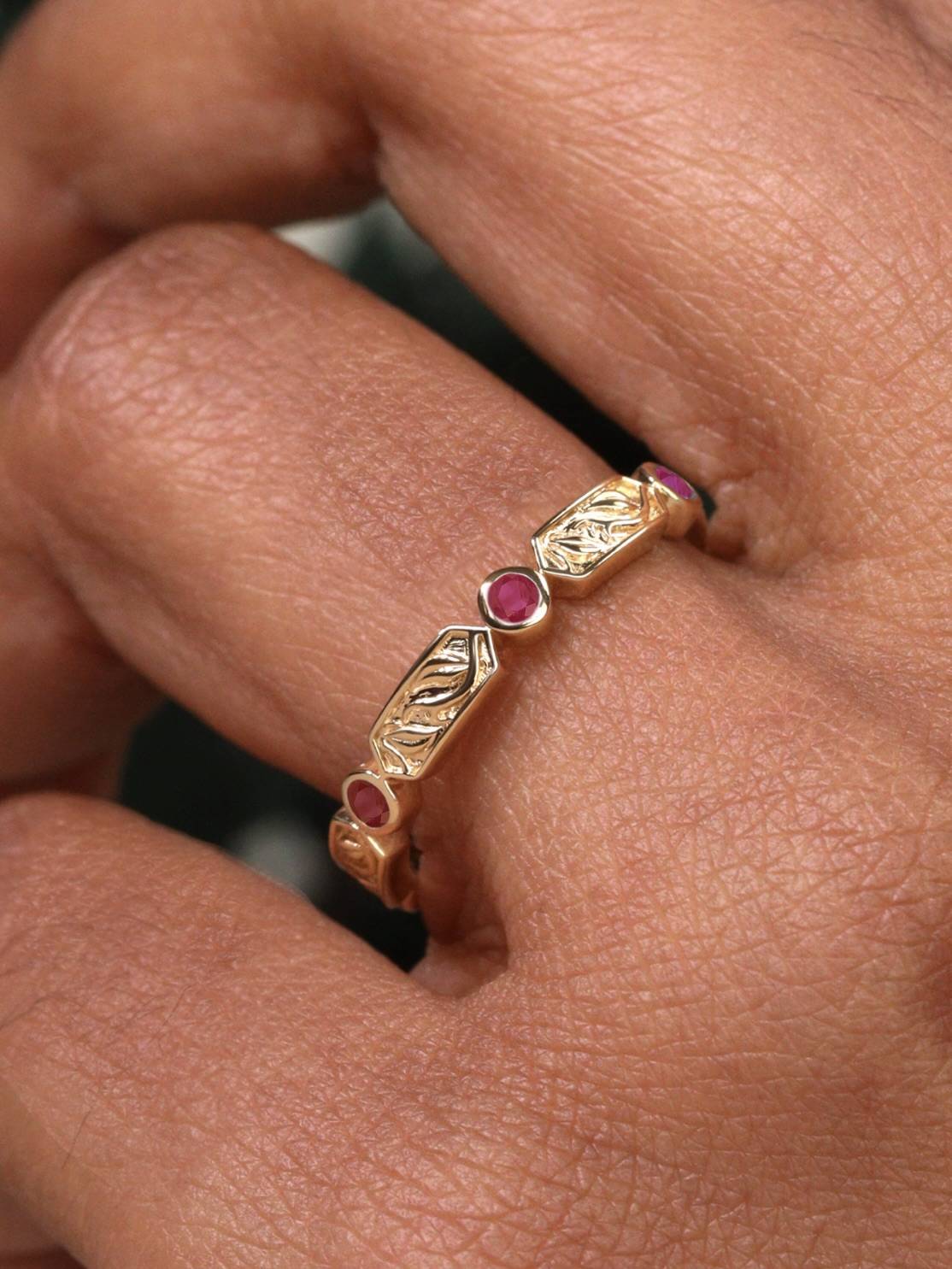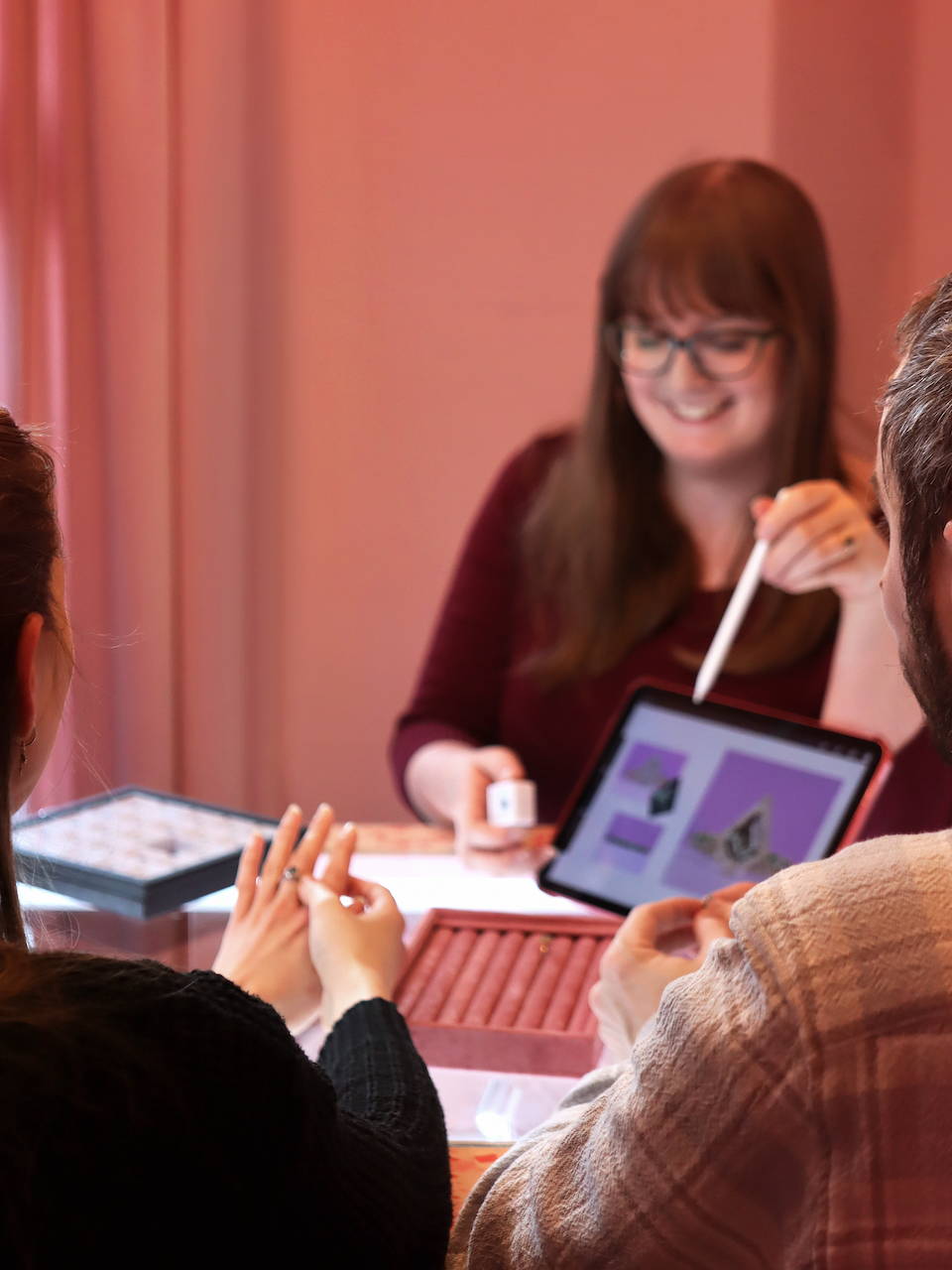GEMSTONE GUIDES
Ruby Gemstone Guide
What could be more classic than a ruby! It was dubbed the ‘king of gems’ for a reason, and while diamond has been in the spotlight for the last fifty years, the rest of the precious gemstone quartet is not-so-quietly making its comeback. Rubies, sapphires and emeralds are all moving up to centre stage, but right now it's time for a long awaited scarlet solo.
What is a Ruby?
Rubies are one of the four truly precious gemstones out there, and a part of the corundum family, along with sapphire! Like most gems, what decides the colour of a corundum stone is all down to the ground they are grown in! Only the presence of chromium will produce a ruby. Rubies have traditionally been used in jewellery for hundreds of years due to their rarity, durability, and notorious colour.
They are also one of the few gemstones where inclusions are acceptable in high-grade stones. Inclusions are so central to their makeup that a ruby without inclusions is a big warning sign that the stone could be fake!
These inclusions are called ‘Silks’ as they look like the threads in (you guessed it) silk. In rare cases these silks will grow in just the right way to create a star in the centre. This special star is called an asterism (meaning pattern of stars) and can be found in rubies, sapphires, and a variety of semi and non-precious gemstones like spinel.
Ruby Meaning
Traditionally rubies have been associated with love, health and financial success! Some cultures also believed them to act as protection against diseases and they have been worn as talismans and signifiers of status for thousands of years. Rubies are also the birthstone of July and the traditional gift for a 40th wedding anniversary.
Rubies even have their own folklore, as some of these gemstones have such luminescent properties that they will glow in sunlight, leading to tales of the stone giving off heat and even boiling water.
Shop Ruby Collection
If you're looking for a piece of ruby jewellery, take a look at our collection of engagement and wedding rings or book an appointment to begin your bespoke journey.

Ruby Value
Natural rubies are always going to be on the more expensive end of the gemstone spectrum, but there are still a lot of options for various budgets depending on the carat you choose. The average price of a ruby dependant on its carat weight is listed below.
Another thing to consider when you are looking at your budget is the size and quality of the stone. A larger ruby stone with a higher carat may still be cheaper than a smaller and lower carat stone, if it is of a lower quality! Rubies are graded on a letter scale, with AAA as the highest quality stone. If you’re wondering how much a ruby is worth, a great way to check it out is by making sure you have all the details of your stone, then you can do a bit of digging!
Rubies are more expensive than most gemstones, but their price tag is genuine. Where other gemstones may have inflated prices, you know what if you decide to splash out on a ruby, you're getting exactly what you pay for. If the cost puts you off, a synthetic ruby or a garnet are great alternatives.

Ruby Hardness
Both Synthetic rubies and natural rubies have a hardness of 9 on the MOHS scale, making them excellent for any piece of jewellery, especially rings! A hard wearing stone is less likely to be damaged by frequent wear, so choosing a ruby for an engagement or right hand ring is a great decision!
A ruby is the perfect choice for daily wear! While you should still take care with any gemstone, a stone with a hardness score above 7.5 is likely to be a good choice for any daily wear jewellery.
The Mohs scale of mineral hardness is a scale used to measure the scratch resistance of various minerals. It assigns a relative hardness value to minerals based on their ability to scratch or be scratched by other minerals. With 10 being the hardest (diamond).

Ruby Rarity
Rubies are considerably rarer than their corundum sibling, sapphire - and even much rarer than diamonds! Ruby is also one of the gems that has been used for the longest time, with its first discovery estimated at around five thousand years ago! The largest gem-quality ruby ever found was the Estrela de Fura, clocking in at 101 carats.
How are Rubies Formed?
Rubies are formed much the same way as all other gemstones: as a result of incredibly high heat and pressure thousands of miles under the earth. Add a touch of aluminium and oxygen and squeeze real hard, and you get corundum! The final addition is chromium to create a ruby gemstone. The exact amount of chromium and presence of other minerals will decide the final shade of a natural ruby.
Lab Grown Rubies
Lab grown rubies are a fantastic option for anyone who doesn't like the look of the price-tag that comes with a natural ruby, or is looking for a more ethical or sustainable alternative to mined-gemstones.
Lab grown rubies have many advantages over natural rubies in terms of price, availability, and clarity. While natural rubies are known for their silk inclusions, there are still natural rubies that are clear of these threads, and these tend to fetch the highest prices. With a lab grown ruby - you mostly get this kind of clarity as standard, this same difference occurs between lab grown and natural emeralds! However, if this extra texture is why you favour these gemstones, a natural mined ruby may still be the way to go.
Where do Rubies Come From?
Rubies are found all across the world, but the highest quality ruby stones are found in Myanmar (previously known as Burma). Other places well known for their ruby gemstones include Thailand and the USA!
Ruby Colours
Known for their stunning saturated colour, ruby gemstones come in all shades of red, with their various pinky, purple and brown tones serving as an indication of where these gems are found! The deep purple rubies tend to be found in Myanmar, whereas a more brown-toned stone is likely to be from Thailand.
This lovely variety is all down to the ground they are grown in. While all rubies need chromium to grow red in the first place, the different minerals in the soil across the globe means we get a buffet of beautiful colours to choose from.
As they tend to be of the highest quality, Burmese rubies are among the most valuable gemstones in the world. This is due to the excellent clarity of the stones and the presentation of a pure red-colour!
The most expensive ruby colour is definitely pigeon's blood red. While it does have a bit of an unconventional name, rubies in this fantastic tone are what brought the gem its fame, and tend to be the rarest and highest quality!

Caring For Your Ruby
Rubies do not scratch very easily! They are among the highest scoring gemstones on the MOHS scale, and so can only really be scratched by other rubies, sapphires or diamonds. This doesn't mean you should test out your ruby ring on every surface trying to prove us wrong through! Enough impact can still shatter or crack your stone, so care is always needed!
There are many things to consider when it comes to caring for any piece of jewellery, but special care should be taken when it comes to gemstones! Like people, every gem has different needs. Here are a few do’s and don’ts to bear in mind when caring for your ruby.
Do clean your ruby gently on a regular basis: All you need is some warm water, a soft bristle brush and a few drops of a fragrance-free washing up liquid. Add the washing liquid to the warm water and carefully give your jewellery a little dip and scrub. Then just rinse under running water and dry with a lint free cloth and you're good to go!
Don’t wear your ruby jewellery during sports. This should be a no-go with any jewellery, as it can be dangerous for both you and your gemstone. You should avoid any kind of overly physical activity to avoid potential knocks, claws catching or breaking, dents and stone losses! This includes swimming as chlorine and salt water can be especially harsh for your ruby!
Do avoid extreme temperatures: Very high and very low temperatures can cause your stone to crack, so don’t leave it next to the radiator, and be careful if you live somewhere with extreme cold!
Don’t wear your stone while cleaning: Especially if your ruby is set in a ring, you need to be wary of cleaning products and cosmetics. Coming into contact with bleach is one of the worst things for your stone!
Many rubies with inclusions are treated with heat or have the inclusion filled with lead-glass to improve the structural stability and appearance of the stone. Bleach and lead-glass are not friends! So pop your jewellery back in its box while you tackle the house.
If you think your jewellery needs a refresh by a professional, book in for our repair and refresh service!
The Jessica Flinn Showroom
At Jessica Flinn, we pride ourselves on creating a friendly atmosphere where all are welcome. If you book an in person appointment with us you will be welcomed into our beautiful showroom with a beverage of your choice, whether its a cup of coffee or a glass of champagne, we're here to make your appointment as memorable as possible. One of our experts will then guide you through the ring choosing or designing journey and make sure you leave with a ring you absolutely adore!
Book an appointment today and start your journey.






